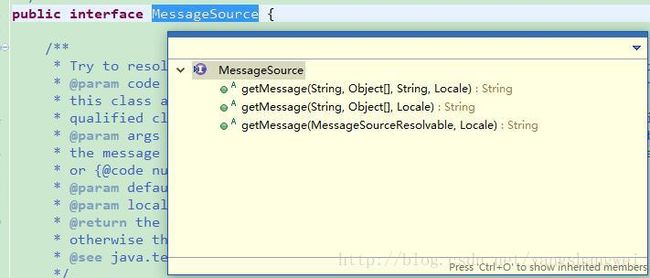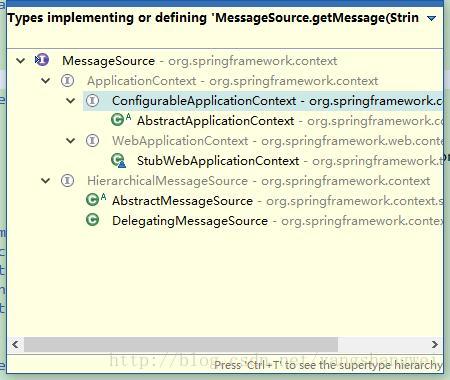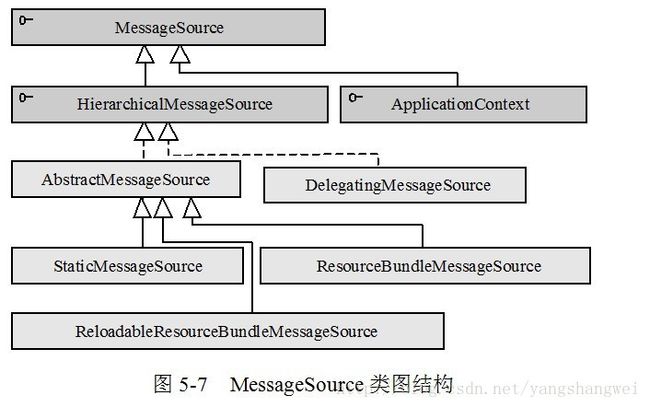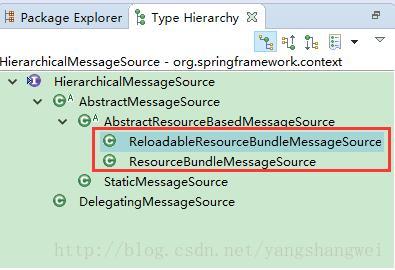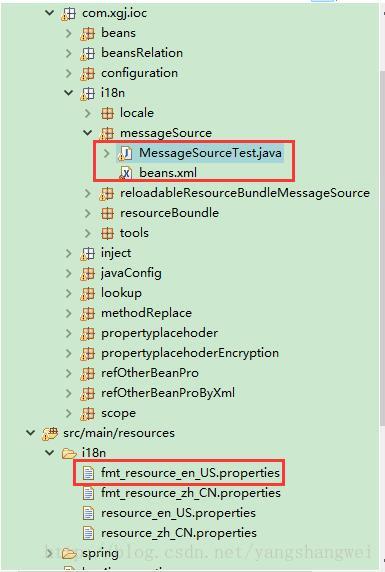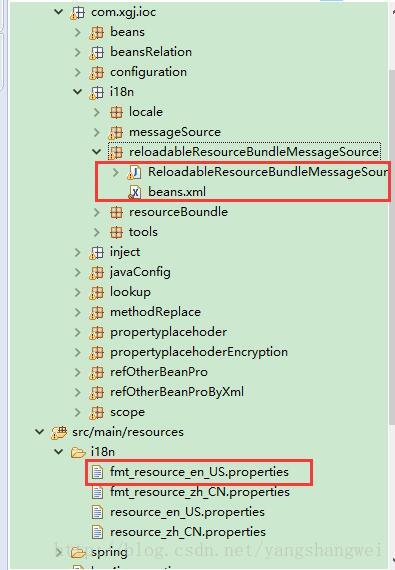Spring-国际化信息02-MessageSource接口
- 导读
- 概述
- MessageSource接口方法
- MessageSource类结构
- ResourceBundleMessageSource
- 实例
- ReloadableResourceBundleMessageSource
- 实例
导读
Spring-国际化信息01-基础知识
Spring-国际化信息02-MessageSource接口
Spring-国际化信息03-容器级的国际化信息资源
概述
spring定义了访问国际化信息的MessageSource接口,并提供了几个易用的实现类.
MessageSource接口方法
我们先看下源码,先来了解一下该接口的几个重要方法
String getMessage(String code, Object[] args, String defaultMessage, Locale locale)
code表示国际化资源中的属性名;args用于传递格式化串占位符所用的运行期参数;当在资源找不到对应属性名时,返回defaultMessage参数所指定的默认信息;locale表示本地化对象;String getMessage(String code, Object[] args, Locale locale) throws NoSuchMessageException;
与上面的方法类似,只不过在找不到资源中对应的属性名时,直接抛出NoSuchMessageException异常;
String getMessage(MessageSourceResolvable resolvable, Locale locale) throws NoSuchMessageException;
MessageSourceResolvable 将属性名、参数数组以及默认信息封装起来,它的功能和第一个接口方法相同。
MessageSource类结构
其中:
HierarchicalMessageSource接口添加了两个方法,建立父子层级的MessageSource结构 ,setParentMessageSource (MessageSource parent)方法用于设置父MessageSource,而getParentMessageSource()方法用于返回父MessageSource。
HierarchicalMessageSource接口最重要的两个实现类是
ResourceBundleMessageSource 和ReloadableResourceBundleMessageSource。
- 它们基于Java的ResourceBundle基础类实现,允许仅通过资源名加载国际化资源。
- ReloadableResourceBundleMessageSource提供了定时刷新功能,允许在不重启系统的情况下,更新资源的信息。
- StaticMessageSource主要用于程序测试,它允许通过编程的方式提供国际化信息。
- DelegatingMessageSource是为方便操作父MessageSource而提供的代理类。
ResourceBundleMessageSource
该实现类允许用户通过beanName指定一个资源名(包括类路径的全限定资源名),或通过beanNames指定一组资源名.
实例
代码已托管到Github—> https://github.com/yangshangwei/SpringMaster
资源文件:
greeting.common=How are you {0}?,today is {1}
greeting.morning=Good Morning {0}! now is {1,time,short}
greeting.afternoon=Good Afternoon {0}! now is {1,date,long}通过ResourceBundleMessageSource配置Bean
<beans xmlns="http://www.springframework.org/schema/beans"
xmlns:util="http://www.springframework.org/schema/util" xmlns:xsi="http://www.w3.org/2001/XMLSchema-instance"
xsi:schemaLocation="http://www.springframework.org/schema/beans
http://www.springframework.org/schema/beans/spring-beans.xsd
http://www.springframework.org/schema/util
http://www.springframework.org/schema/util/spring-util.xsd">
<bean id="resource"
class="org.springframework.context.support.ResourceBundleMessageSource">
<property name="basenames" ref="resourceList"/>
bean>
<util:list id="resourceList">
<value>i18n/fmt_resourcevalue>
util:list>
beans>
测试类
启动Spring容器,并通过MessageSource访问配置的国际化资源
package com.xgj.ioc.i18n.messageSource;
import java.util.GregorianCalendar;
import java.util.Locale;
import org.springframework.context.ApplicationContext;
import org.springframework.context.MessageSource;
import org.springframework.context.support.ClassPathXmlApplicationContext;
public class MessageSourceTest {
public static void main(String[] args) {
ApplicationContext ctx = new ClassPathXmlApplicationContext(
"classpath:com/xgj/ioc/i18n/messageSource/beans.xml");
// 获取MessageSource的Bean
MessageSource messageSource = ctx.getBean("resource",
MessageSource.class);
// 动态参数
Object[] objs = { "Xiaogongjiang", new GregorianCalendar().getTime() };
// 获取格式化的国际化信息
String msg1 = messageSource.getMessage("greeting.common", objs,
Locale.CHINESE);
String msg2 = messageSource.getMessage("greeting.morning", objs,
Locale.US);
String msg3 = messageSource.getMessage("greeting.afternoon", objs,
Locale.CHINESE);
System.out.println(msg1);
System.out.println(msg2);
System.out.println(msg3);
}
}
运行结果:
通过Spring我们无须再分别加载不同语言、不同国家/地区的本地化资源文件,仅仅通过资源名就可以加载整套的国际化资源文件。此外,我们无须显式使用MessageFormat操作国际化信息,仅通过MessageSource# getMessage()方法就可以完成操作了.
比较下 和 http://blog.csdn.net/yangshangwei/article/details/76946002#resourceboundle 这里的区别。
ReloadableResourceBundleMessageSource
该实现类比之于ResourceBundleMessageSource的唯一区别在于它可以定时刷新资源文件,以便在应用程序不重启的情况下感知资源文件的变化。很多生产系统都需要长时间持续运行,系统重启会给运行带来很大的负面影响。这时,通过该实现类就可以解决国际化信息更新的问题
实例
资源文件同上
通过ReloadableResourceBundleMessageSource配置资源
<beans xmlns="http://www.springframework.org/schema/beans"
xmlns:util="http://www.springframework.org/schema/util" xmlns:xsi="http://www.w3.org/2001/XMLSchema-instance"
xsi:schemaLocation="http://www.springframework.org/schema/beans
http://www.springframework.org/schema/beans/spring-beans.xsd
http://www.springframework.org/schema/util
http://www.springframework.org/schema/util/spring-util.xsd">
<bean id="resource"
class="org.springframework.context.support.ReloadableResourceBundleMessageSource">
<property name="basenames" ref="resourceList"/>
<property name="cacheSeconds" value="5"/>
bean>
<util:list id="resourceList">
<value>i18n/fmt_resourcevalue>
util:list>
beans>
我们通过cacheSeconds属性让ReloadableResourceBundleMessageSource每5秒钟刷新一次资源文件(在真实的应用中,刷新周期不能太短,否则频繁的刷新将带来性能上的负面影响,一般不建议小于30分钟)。cacheSeconds默认值为-1表示永不刷新,此时,该实现类的功能就蜕化为ResourceBundleMessageSource的功能。
测试类:
package com.xgj.ioc.i18n.reloadableResourceBundleMessageSource;
import java.util.GregorianCalendar;
import java.util.Locale;
import org.springframework.context.ApplicationContext;
import org.springframework.context.MessageSource;
import org.springframework.context.support.ClassPathXmlApplicationContext;
public class ReloadableResourceBundleMessageSourceTest {
public static void main(String[] args) throws Exception {
ApplicationContext ctx = new ClassPathXmlApplicationContext(
"classpath:com/xgj/ioc/i18n/reloadableResourceBundleMessageSource/beans.xml");
MessageSource messageSource = ctx.getBean("resource",
MessageSource.class);
Object[] objects = { "XiaoGongJiang", new GregorianCalendar().getTime() };
for (int i = 0; i < 2; i++) {
String msg = messageSource.getMessage("greeting.common", objects,
Locale.US);
System.out.println(msg + "\nsleep 20S");
Thread.sleep(20000);
}
}
}
让程序睡眠20秒钟,在这期间,我们将fmt_resource_en_US.properties 中的 greeting.common改为
greeting.common=***How are you {0}?,today is {1}运行结果:
两次输出的格式化信息分别对应更改前后的内容,也即本地化资源文件的调整被自动生效了
